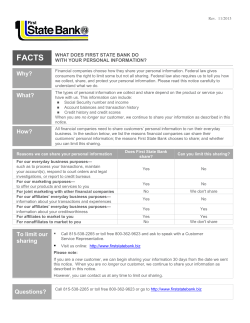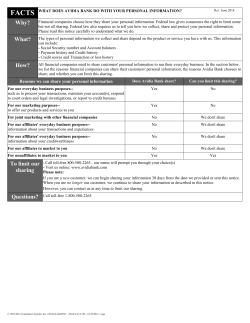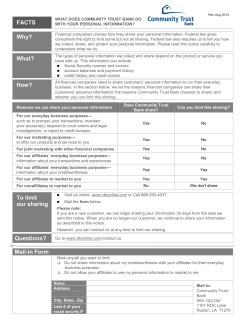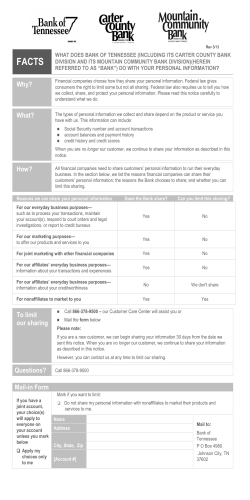
May 21, 2014 Walter E. Washington Convention Center Washington, DC USA
May 21, 2014 Walter E. Washington Convention Center Washington, DC USA 1 Copyright © 2014, Oracle and/or its affiliates. All rights reserved. How to Build a Better GIS Application Siva Ravada Senior Director of Development Spatial and Graph & MapViewer Oracle Program Agenda A Land Management Application Building New Geometry Functions Automated Map Simplification 3 Copyright © 2014, Oracle and/or its affiliates. All rights reserved. Important Topics covered Data Model based database design Trigger based spatial constraints Polygon snapping techniques Topologically consistent Map Generalization Data publishing with MapViewer 4 Copyright © 2014, Oracle and/or its affiliates. All rights reserved. System Architecture Copyright © 2014, Oracle and/or its affiliates. All rights reserved. Java Stored Procedures Web Services 5 GDAL Data input in file format (from local government agencies) PL/SQL Procedures National Maps at different scales System Input The data for the system is supplied in large files by various local government institutions Local Government institutions maintain their own data – This will result in small differences due to different standards for data collection – These differences cause many small overlaps and gaps in the system One of the main tasks of the system is to collect the data from various government institutions into a seamless map – In this process geometries are checked for overlaps and gaps and are corrected with an automated process 6 Copyright © 2014, Oracle and/or its affiliates. All rights reserved. Data Publishing System Input HTTP request – Region of interest – Map Scale Output – XML response file with the map data – GeoJSON response file with map data – WFS – WMS 7 Copyright © 2014, Oracle and/or its affiliates. All rights reserved. Define a Data Model A spatial database should be designed just like any other database with a fully specified model – A fully specified model that is application independent should control spatial data storage – A good data model supports and enhances data access without compromising quality Database features should be used to support limitations of specific applications rather than limiting the data model – For example, some applications mandate a single spatial column per table or only a single homogeneous geometry type per spatial column These limitations can be accommodated using database features like views and triggers 8 Copyright © 2014, Oracle and/or its affiliates. All rights reserved. Use database check constraints Use LAYER_GTYPE to constrain the feature types stored in a table – Very important to do this to avoid problems in the applications Spatial constraints can be created using PL/SQL code – A spatial constraint is a data consistency check that makes sure the data stored in the spatial layers follows certain spatial rules – For example, it may be that a building footprint should always be contained within a land parcel or a road should never cross a land parcel – The most common way to enforce this is to define triggers on the tables and check for data consistency as soon as a new row is inserted If the constraints are implemented at the DB level, all applications accessing the data will share the same data quality checks 9 Copyright © 2014, Oracle and/or its affiliates. All rights reserved. Examples of Spatial constraints CONTAINS: A land parcel may contain a building footprint COVERS: A planning neighbourhood covers a land parcel EQUAL: A planning neighbourhood can be equal to a land parcel TOUCH: A road segment can only touch another road segment CONTAINS+COVERS: A land parcel may contain and cover a building footprint Complex rules: Two land parcels may not overlap and there should be no gaps between adjacent land parcels All of these can be implemented in the DB using PL/SQL code and existing spatial functions 10 Copyright © 2014, Oracle and/or its affiliates. All rights reserved. Implementing New Functions SDO_GEOMETRY is an open type and easy to understand Existing functionality in the DB can be extended using PL/SQL or Java stored procedures Example: Swapping ordinates in the geometry – Data comes in as lat/long, but SDO_GEOMETRY expects it as long/lat – Does the client need to do the conversion ? – Can be easily done in PL/SQL on insert into the table 11 Copyright © 2014, Oracle and/or its affiliates. All rights reserved. Detecting overlaps between polygons SDO_GEOM.RELATE function used to detect if there is an overlap between two polygons – If the relationship between them is TOUCH there is no overlap There may be gaps between them Overlap 12 Copyright © 2014, Oracle and/or its affiliates. All rights reserved. No Overlap Overlap Correction A A B (A -B) 13 Copyright © 2014, Oracle and/or its affiliates. All rights reserved. Detecting gaps between polygons Take the outer rings of polygons A and B SDO_UNION both the outer rings – If the resulting polygon has holes (interior rings) then there are gaps between the two input polygons AUB 14 Copyright © 2014, Oracle and/or its affiliates. All rights reserved. Fixing gaps between polygons Extract the inner rings and add them to Polygon B – SDO_UTIL.EXTRACT function can be used in the DB – SDO_UNION of inner ring with Polygon B Extract inner ring SDO_UNION Final Result 15 Copyright © 2014, Oracle and/or its affiliates. All rights reserved. Detecting gaps between polygons In this situation the SDO_UNION method with rings does not work SDO_GEOM.RELATE will say TOUCH – But there are gaps that need to be fixed 16 Copyright © 2014, Oracle and/or its affiliates. All rights reserved. Detecting boundary gaps Explode geometry B into line segments If vertices from geometry A are within 1 meter from edges of geometry B (but not on the edge) then there are gaps between the polygons 1 10 9 2 3 4 5 8 e2 e1 7 e7 6 e3 e6 e4 e5 Vertex 6 (of A) can be snapped to Edge e7 (of B) 17 Copyright © 2014, Oracle and/or its affiliates. All rights reserved. Detecting boundary gaps Find the closest point on polygon B and replace the vertex from A with the closest point from B – Use SDO_UTIL.CLOSEST_POINTS function to find the closest point on e7 from vertex 6 18 Copyright © 2014, Oracle and/or its affiliates. All rights reserved. Generating parallel lines for road centerlines 19 Copyright © 2014, Oracle and/or its affiliates. All rights reserved. Will simple affine transform work ? 20 Copyright © 2014, Oracle and/or its affiliates. All rights reserved. Examine each pair of coordinates Creating lines parallel to the original line requires working with edge of the line geometry Each edge is to be examined to compute the offset vector to use in the affine transform call Each translated edge is extended or shortened to ensure that the resulting lines edges are all touching Easy to incorporate unit parameter to such a function to create parallel lines at a specified distance 21 Copyright © 2014, Oracle and/or its affiliates. All rights reserved. Creating parallel linear features 22 Copyright © 2014, Oracle and/or its affiliates. All rights reserved. Using Spatial Java Stored Procedures Open source Java code available for many functions JTS is one of the most popular java tool kits Easily integrates with Oracle Spatial functionality JTS defines the wrappers required to convert SDO_GEOMETRY to a JTS geometry class Makes it easy to expose any JTS supplied functions as PL/SQL methods in the database JTS is complementary rather than competitive 23 Copyright © 2014, Oracle and/or its affiliates. All rights reserved. Some useful functions from JTS Voronoi diagram generation Line densification Square Buffer 24 Copyright © 2014, Oracle and/or its affiliates. All rights reserved. Topological Generalization of Features Producing cartographic maps at different scales requires generalization of features Object level generalization of individual features can generate a map that is not topologically consistent with the underlying data 25 Copyright © 2014, Oracle and/or its affiliates. All rights reserved. Valid Simplification of Polygons L1 L1 L3 L3 L5 L4 L2 L6 Input data with 6 lines 26 L2 L5 Copyright © 2014, Oracle and/or its affiliates. All rights reserved. L4 L6 A valid simplification Invalid Simplification L1 L3 L3 L5 L5 L4 L2 L2 L6 Input data with 6 lines 27 L1 Copyright © 2014, Oracle and/or its affiliates. All rights reserved. L6 L4 Invalid simplification Valid Simplification of Polygons and Points L1 L1 L3 L3 L2 L5 P3 P4 P5 L6 P1 P2 L4 In put data with 6 lines and 5 point features 28 Copyright © 2014, Oracle and/or its affiliates. All rights reserved. L5 P4 P5 L2 P3 L6 P1 P2 L4 A valid simplification of the 6 lines with 5 point features Invalid Simplification L1 L3 L3 L2 L5 L6 P2 L4 In put data with 6 lines and 5 point features 29 Copyright © 2014, Oracle and/or its affiliates. All rights reserved. L2 L5 P1 P3 P4 P5 L1 P4 P5 P1 P3 L6 P2 L4 Invalid simplification of the 6 lines 5 point features Points P1 and P5 change their relative positions with respect to L1 and L4 Topology based generalization Construct a topology data model for all features in the map All polygonal, linear and point features are added to the topology Topology features are created corresponding to each of the original features Topology data model provides Get_Geometry function to construct the geometry for the feature based on topological elements Each edge of the topology is generalized to reduce the number of vertices Get_Geometry is used to reconstruct the feature geometry with reduced number of vertices 30 Copyright © 2014, Oracle and/or its affiliates. All rights reserved. Topological Simplification 2. Check if the topology is changing 1. Simplify the edge geometry 31 NO YES 3a. Commit the changes to the edge and go to step 1 for the next edge 3b. Discard changes to the edge and go to step 1 for the next edge Copyright © 2014, Oracle and/or its affiliates. All rights reserved. Simplifying Long Edges In the default case, either a edge is completely simplified or not – In some cases, if an edge is very long, simplifying the whole edge may not be possible – But this leaves many vertices that can otherwise be removed Break these long edges by adding additional topological nodes – Break any non-simplified edges with vertices more than a threshold into more than one edge – Then simplify each of the smaller edges 32 Copyright © 2014, Oracle and/or its affiliates. All rights reserved. Adding nodes to long edges n1 n2 Add a new node n3, then simplify n3 n1 33 Copyright © 2014, Oracle and/or its affiliates. All rights reserved. n2 Result of a Topology based Simplification L1 L1 L3 L3 L2 L5 P3 P4 P5 L6 L4 34 Copyright © 2014, Oracle and/or its affiliates. All rights reserved. L5 P1 P2 P4 P5 L2 P3 L6 L4 P1 P2 Use database views to share the same data for different use cases Geographic applications need the exact location, cartographic applications might need objects in different locations to create a pretty map Land management application and a report generation application share the same data But the report generation application wants the 48 states of US and Alaska and Hawaii next to each other on the same page Don’t duplicate the data to move Hawaii and Alaska to feed the reporting application Use database view with spatial functions 35 Copyright © 2014, Oracle and/or its affiliates. All rights reserved. Cartographic Map 36 Copyright © 2014, Oracle and/or its affiliates. All rights reserved. Create a view with Affine Transformations Create a function to transform Alaska and Hawaii .. Function transform(state in varchar2) … if (state=‘AK’) then return sdo_util.affinetransform(geom,….); elsif (state=‘HI’) then return sdo_util.affinetransorm(geom,…) else return geom; Create a view based on this function Create view states_for_report as Select state, transform(geom), … from states The reporting application reads data from the STATES_FOR_REPORT view and the other application read data from STATES 37 Copyright © 2014, Oracle and/or its affiliates. All rights reserved. Share data across different applications Use a data server to easily ship data via a web service Users can specify any SQL level constraints on tables to select relevant data MapViewer data server makes it easy to do this Publishing data as GeoJSON files 38 Copyright © 2014, Oracle and/or its affiliates. All rights reserved. MapViewer Data Server Tile layers Oracle Maps v2 API Tile Server geoJson* Map Data Server hosted LBS • Oracle • Nokia • TomTom • Bing • OSM • et al MapViewer Editor * With some Mapping metadata Data packs / Templates • ESRI • WMS • PostGIS • Teradata • et al • WFS • GeoRSS • WMTS extensions 39 Mapping Engine WMS Server Copyright © 2014, Oracle and/or its affiliates. All rights reserved. OGR adapters Oracle Database Data Server HTTP requests Sample MDS request to get states data, based on a predefined theme /mapviewer/dataserver/mvdemo2? t=theme_demo_states&id_col=state_abrv&include_label_box=tru e Sample MDS request to get USA Zip Codes with simplification applied on the server side (12c only), based on a dynamic query : /mapviewer/dataserver/mvdemo2?t=usa_zipcode&sql=select POSTALCODE, state, cnty, zippy, pc_name, pc_type, pa_name, geometry from zip_us&id_col=postalcode&include_label_box=true&simplify=true &threshold=95&dadp=4 40 Copyright © 2014, Oracle and/or its affiliates. All rights reserved. Supported URL query parameters t: theme name (mandatory) to_srid: data should be tranformed into this SRID before sending to the client (optional) dadp: all cooridnates should have this number of digits after the decimal point; default is 5 (optional) sql: (only used when requesting dynamic query-based theme data) specifis a complete SQL query (mandatory) paramnum: specifies the number of bind variables (to be used for a pre-defined theme that has bind variables in its query condition) included in the request 41 Copyright © 2014, Oracle and/or its affiliates. All rights reserved. What if we want to ship generalized data Starting with MapViewer 12.1.3 simplify: indicates whether geometry should be simplified by the server threshold: if simplify is true, this value specifies the reduction percentage (value must be 1 through 99); e.g. threshold=75 means the geometry should be simplified by 75%, keeping only 25% of the vertices 42 Copyright © 2014, Oracle and/or its affiliates. All rights reserved. Summary Use a good data model independent of application Use as many database features as possible Don’t reinvent the features that are already available in the database Use stored procedures for data management tasks MapViewer has many new powerful features to complement the Spatial features in the database 43 Copyright © 2014, Oracle and/or its affiliates. All rights reserved. May 21, 2014 Walter E. Washington Convention Center Washington, DC USA 44 Copyright © 2014, Oracle and/or its affiliates. All rights reserved. Next: Lunch – Awards & SIG Presentation in Room 150AB (11:45am-1:15pm) 45 Copyright © 2014, Oracle and/or its affiliates. All rights reserved. 4:30-5:00pm: Meet the Experts – roundtable Q&A on topics in Room 150AB – Spatial Performance – Upgrading/Testing Apps for Spatial 12c – Raster & 3D – MapViewer/BI – Certification – SIG User Group Closing Reception (5:00) – Exhibit Hall 46 Copyright © 2014, Oracle and/or its affiliates. All rights reserved.
© Copyright 2025





















